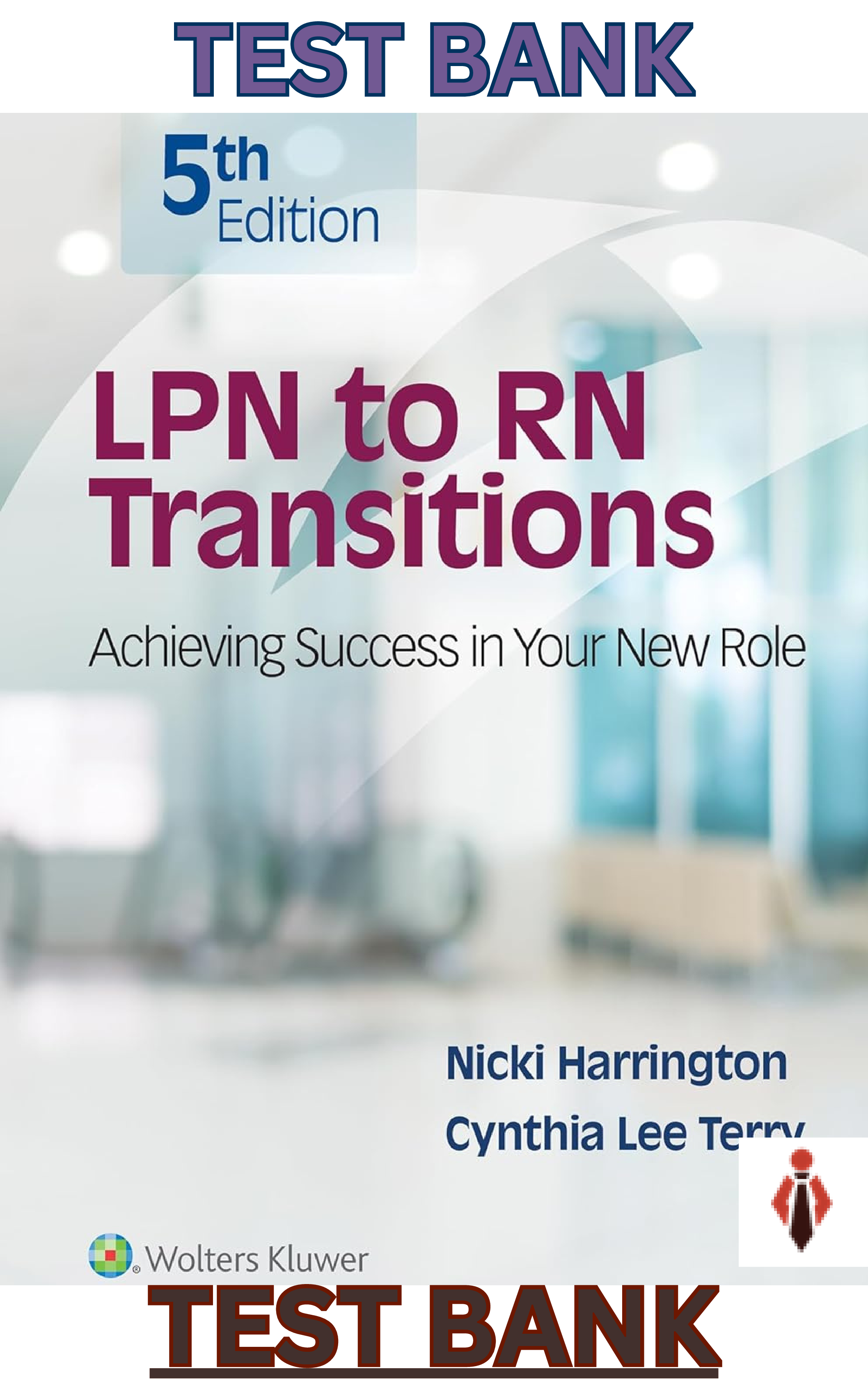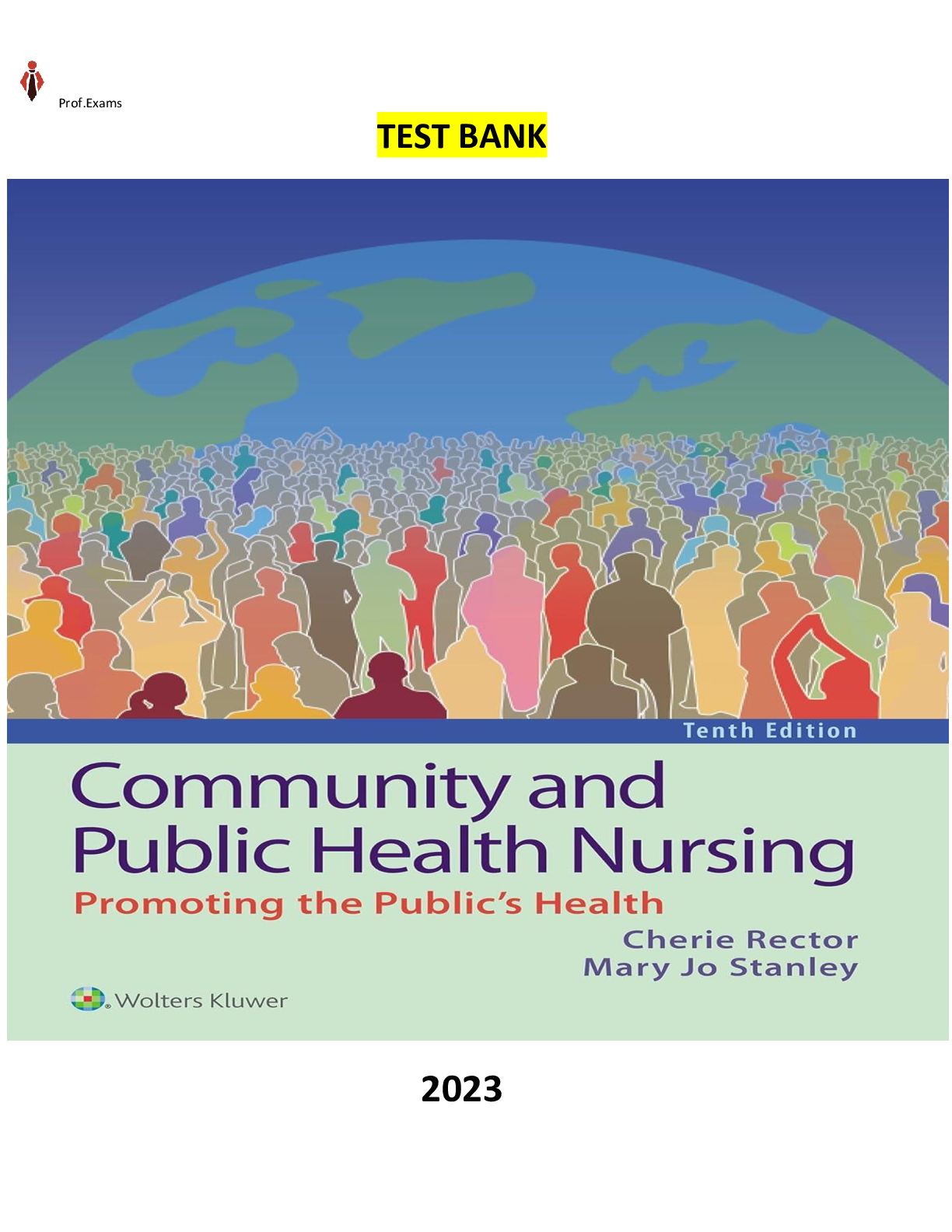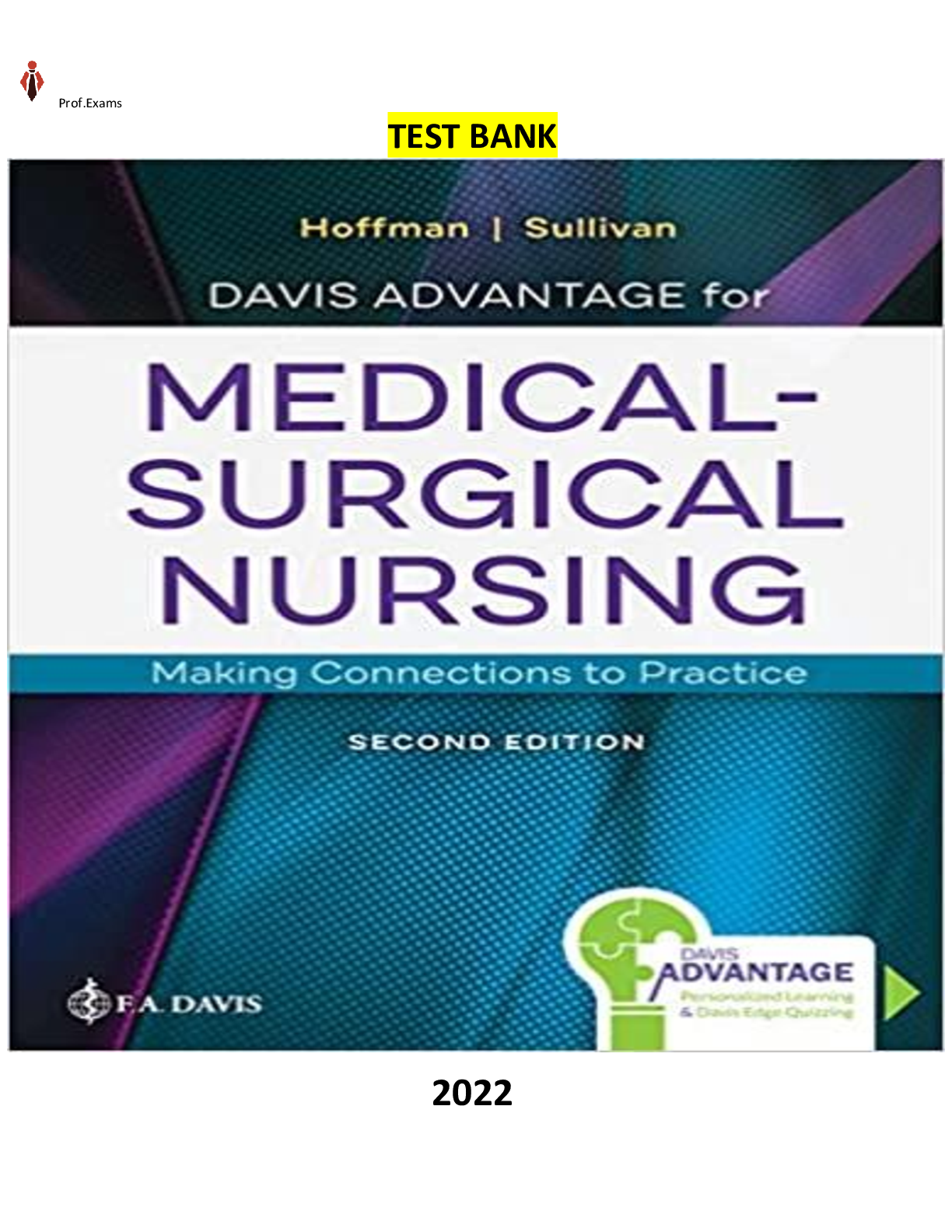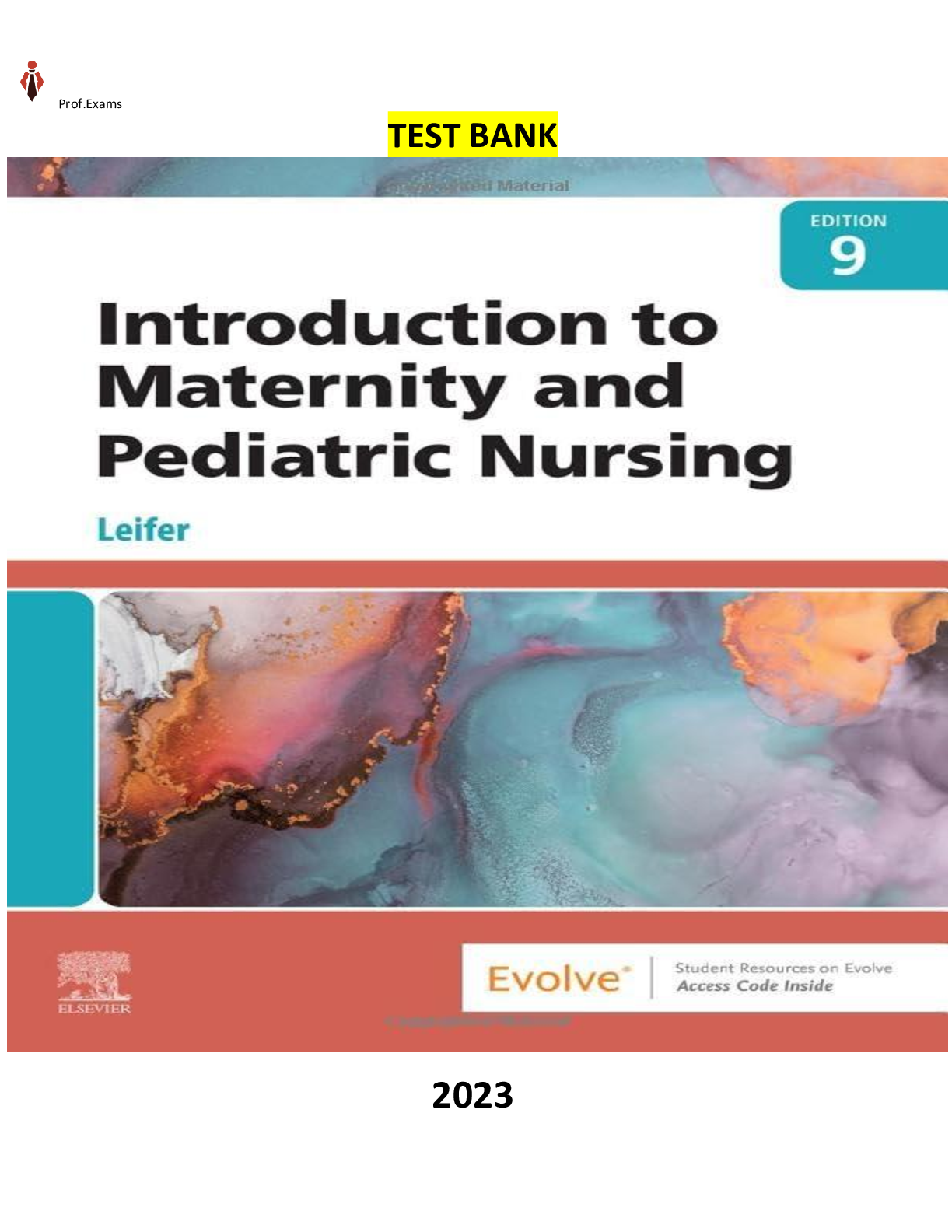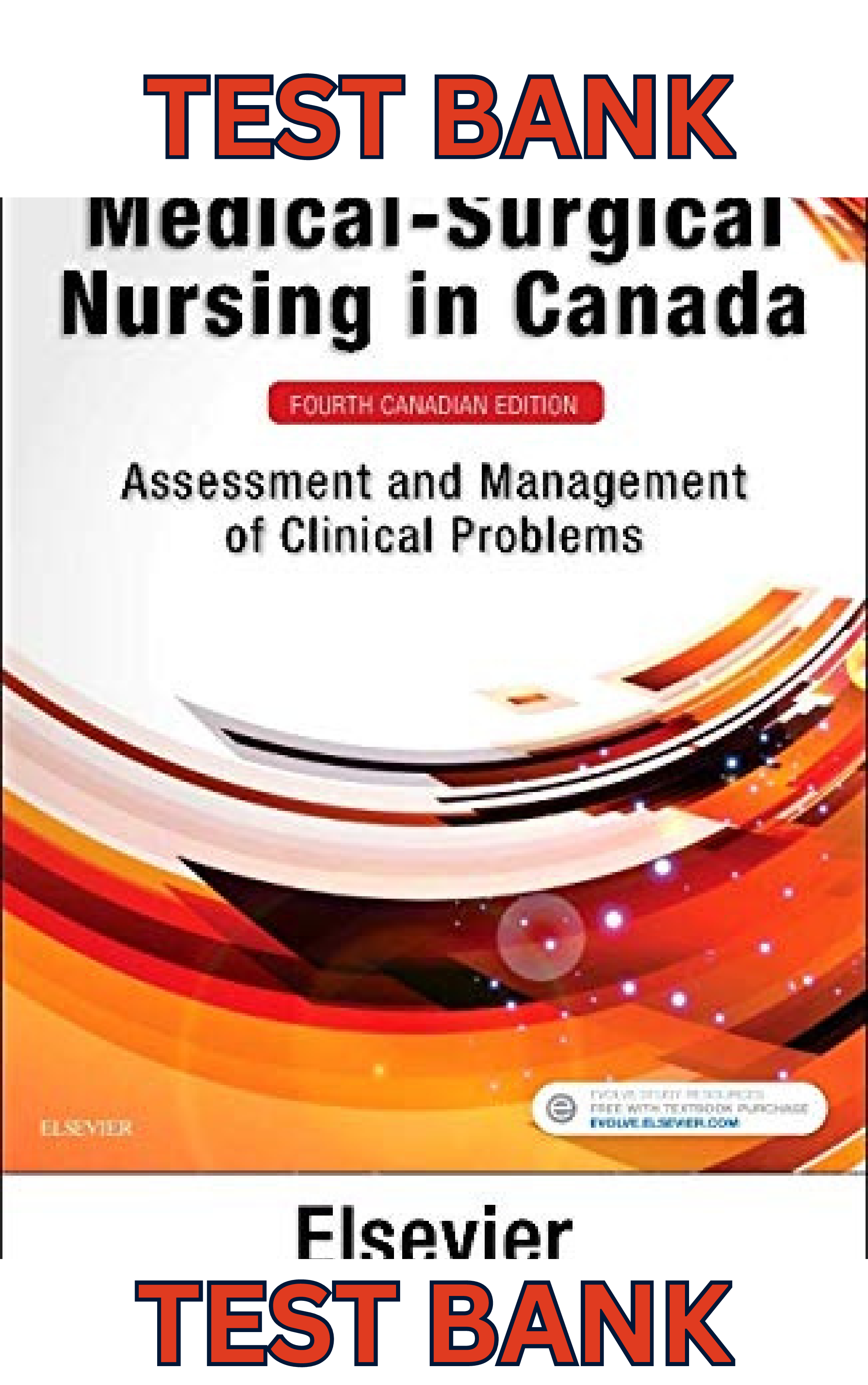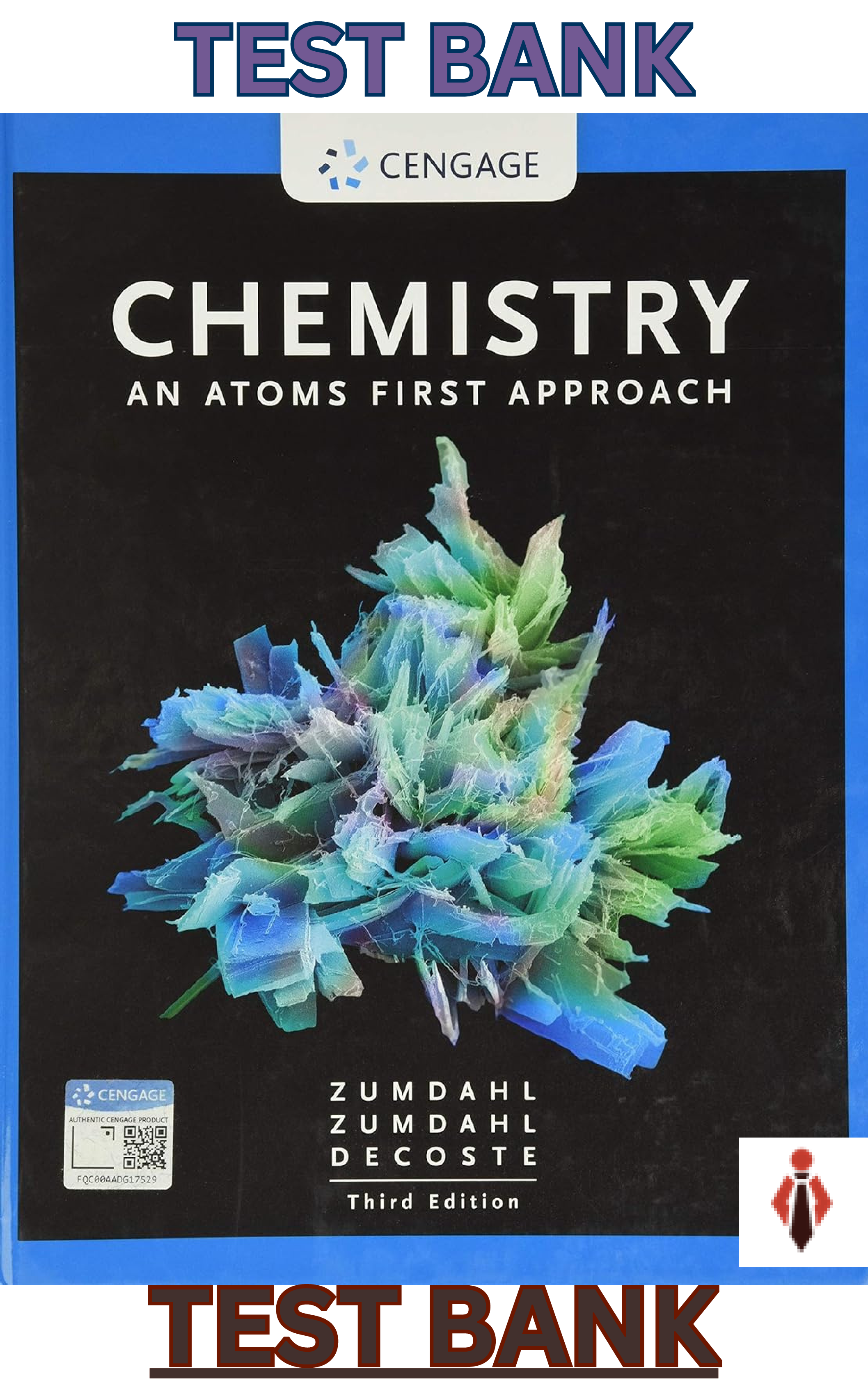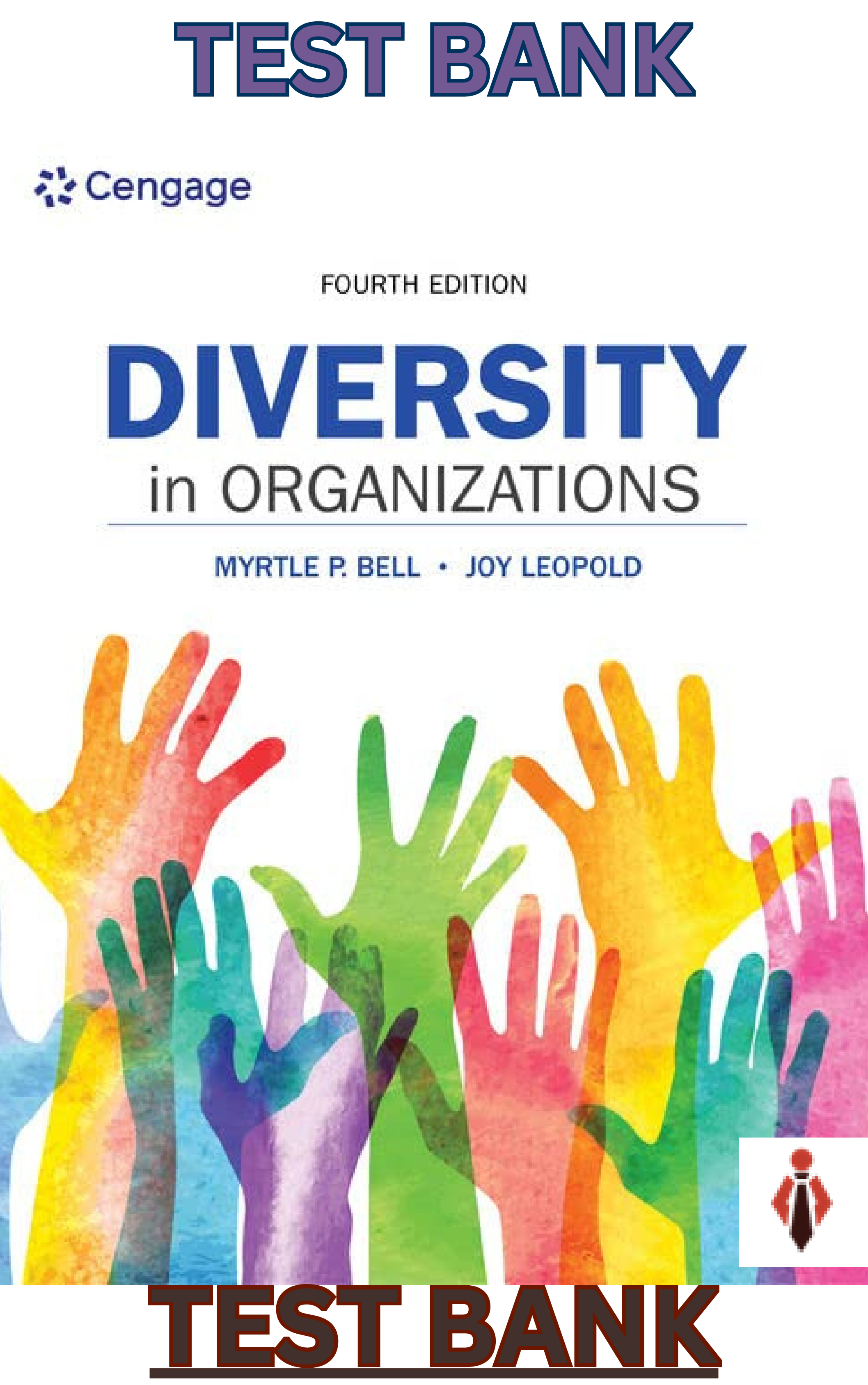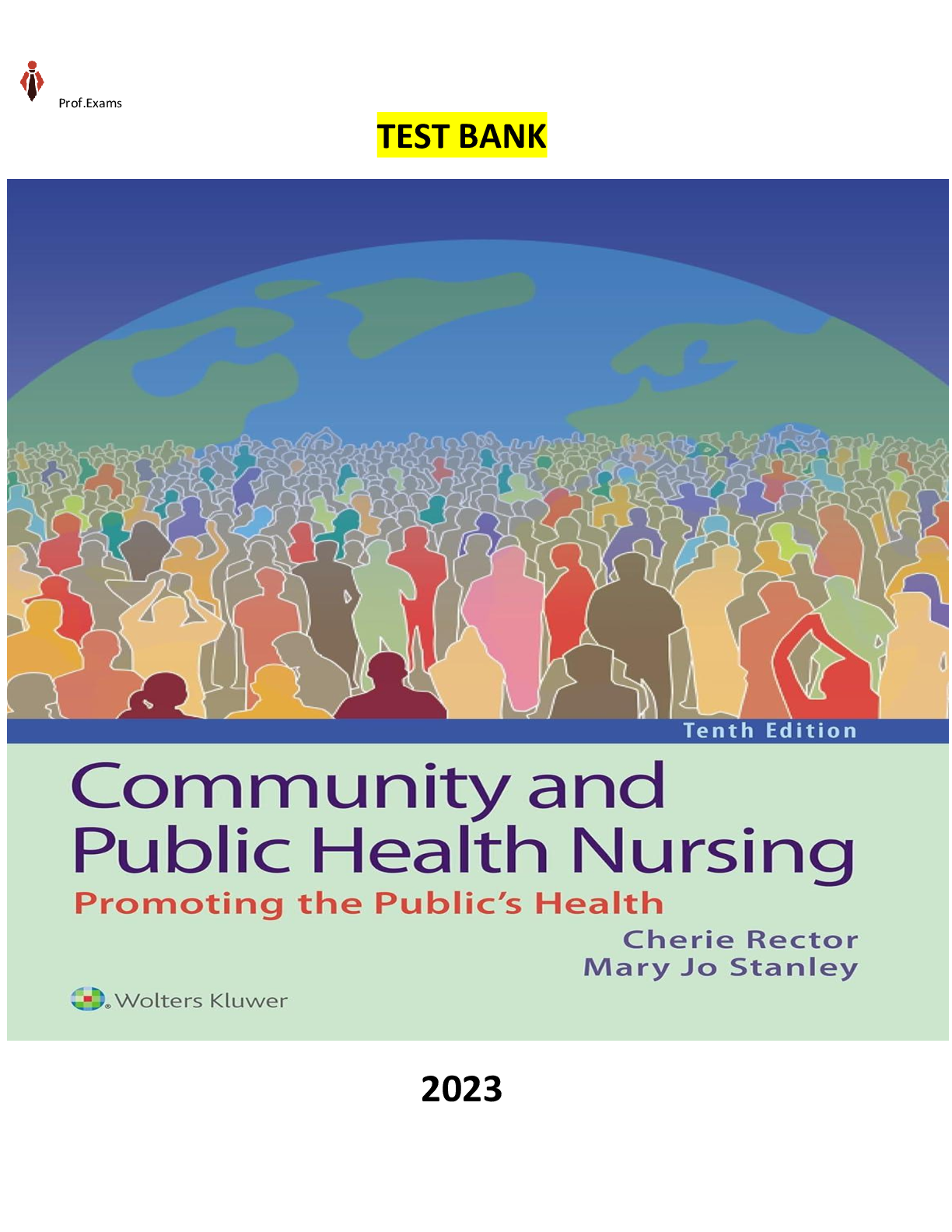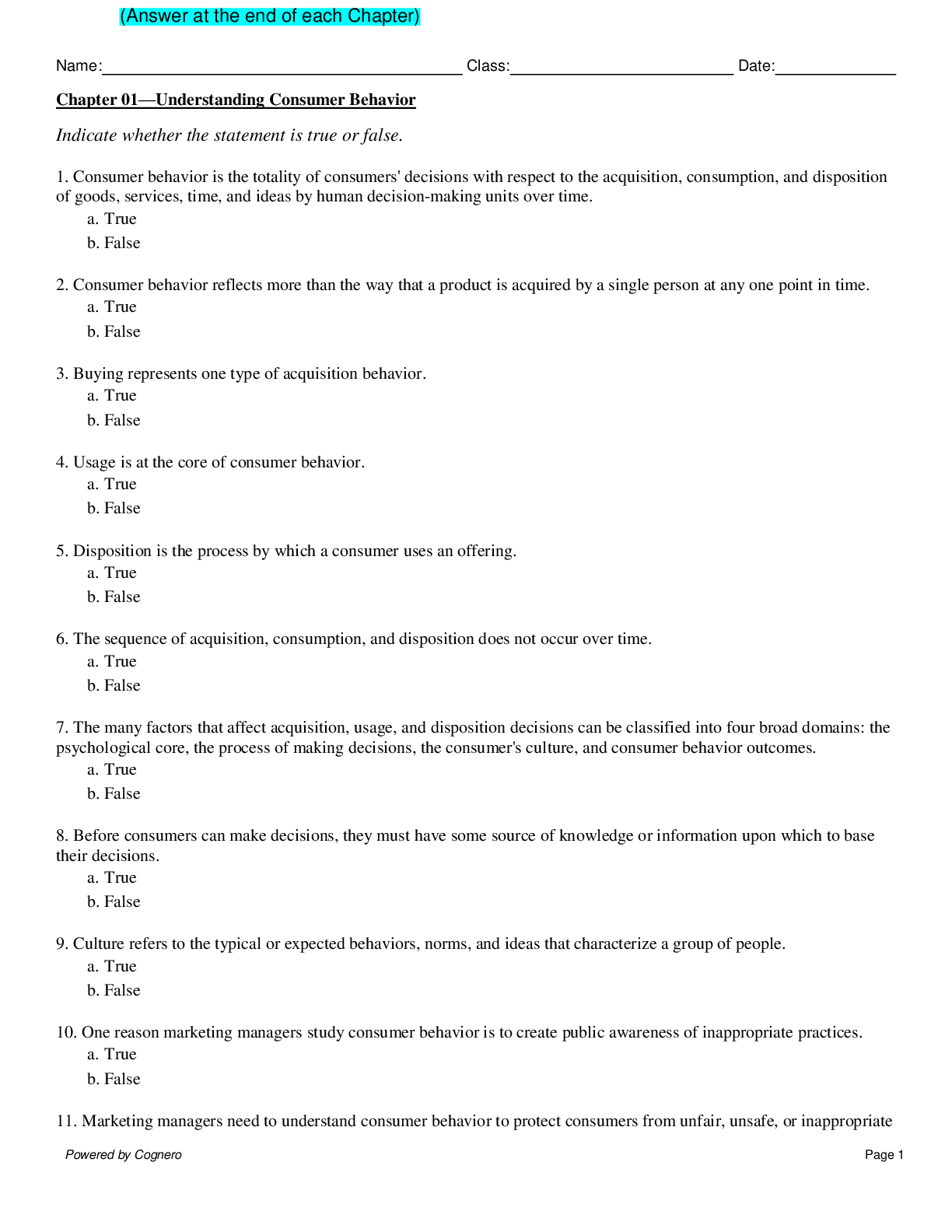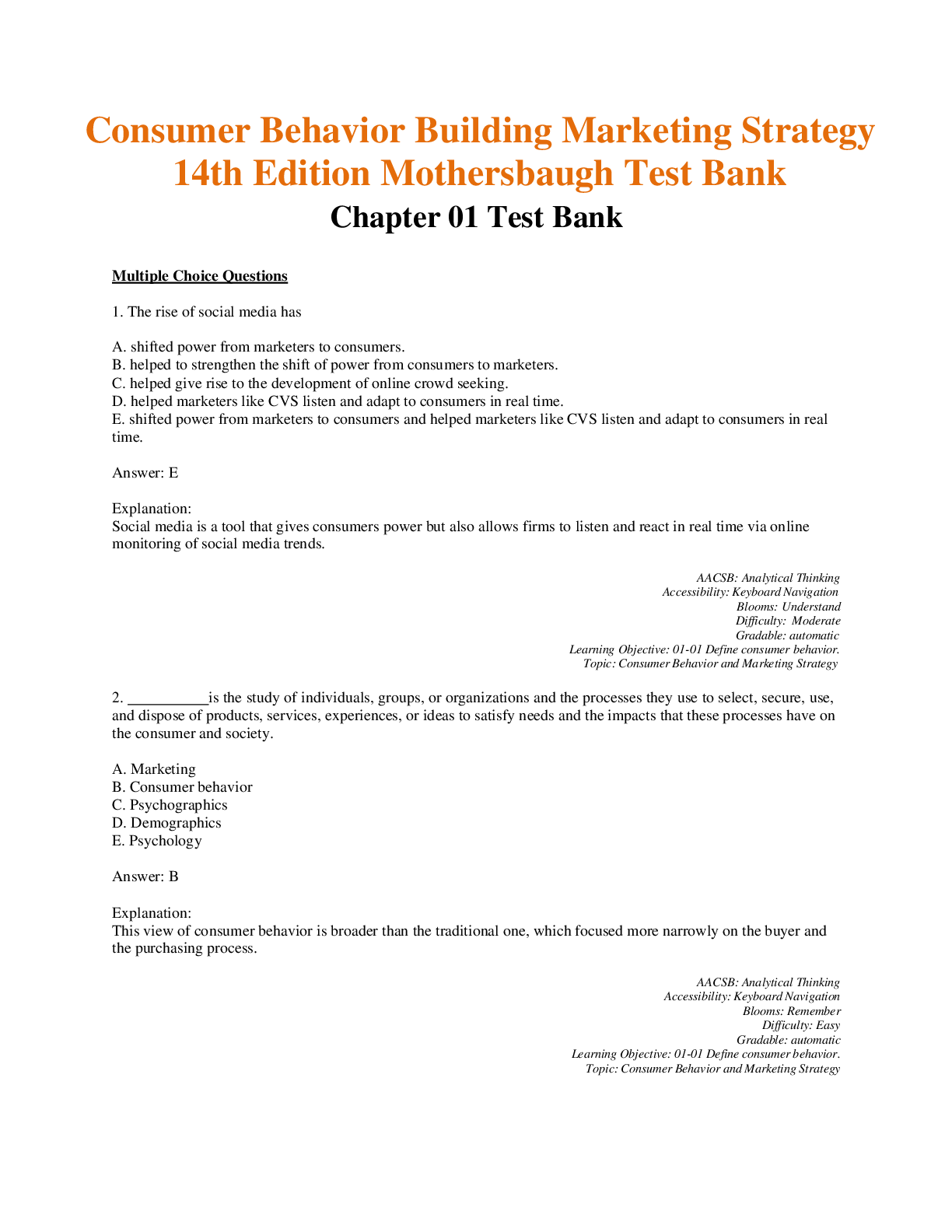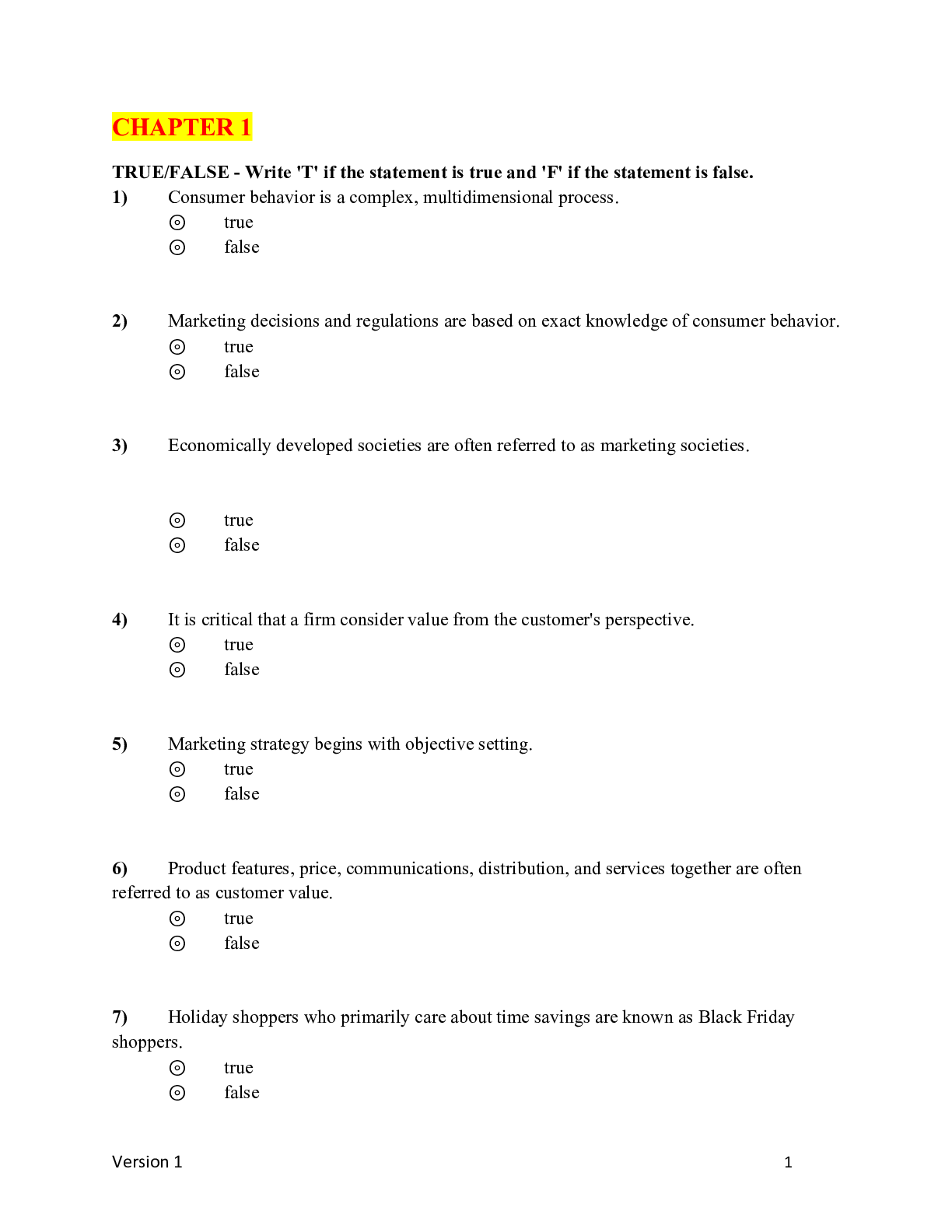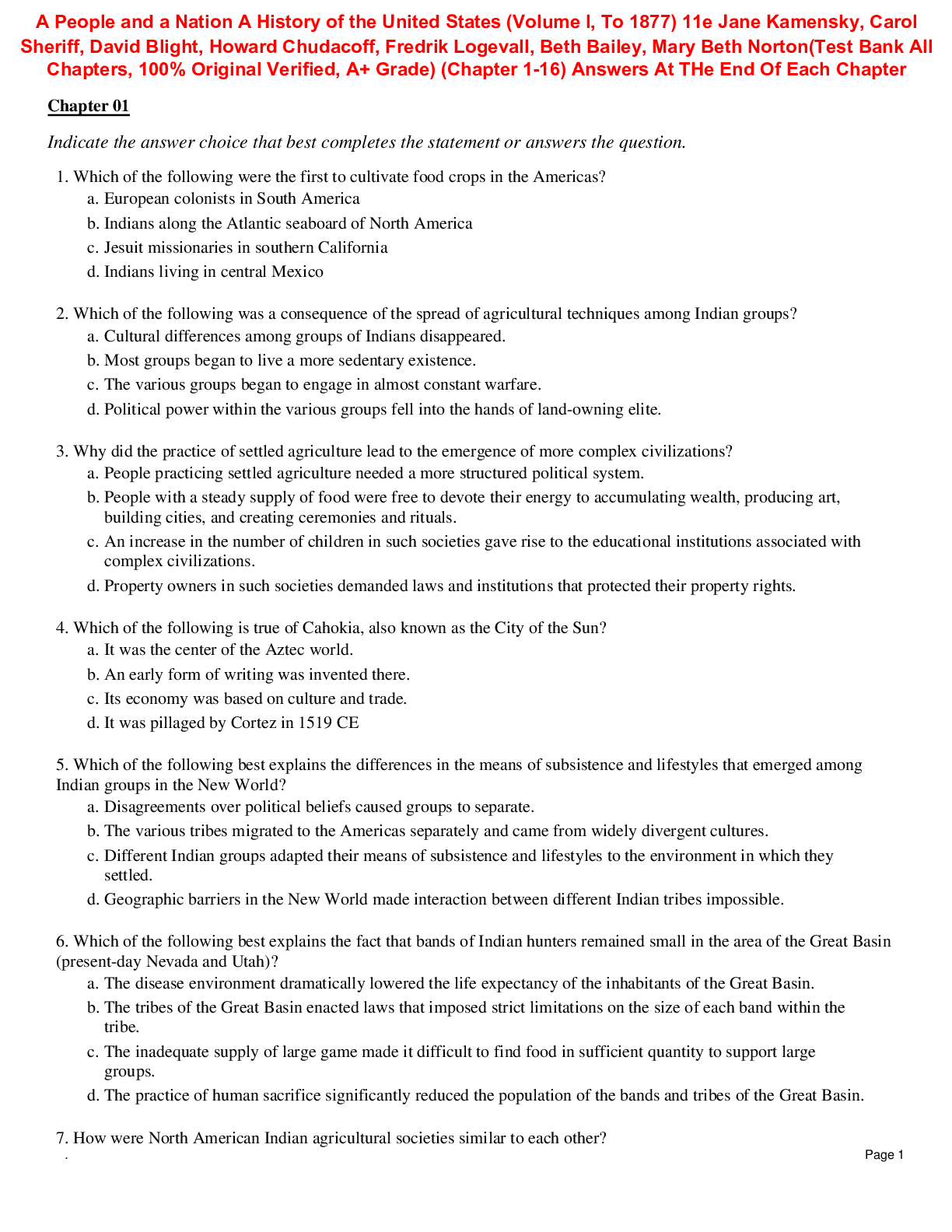*NURSING > TEST BANK > FULL - Test Bank-Exam Questions - Diabetic Questions College of Lake County NUR 134 Diabetic Questio (All)
FULL - Test Bank-Exam Questions - Diabetic Questions College of Lake County NUR 134 Diabetic Questions, Answers and Explanations
Document Content and Description Below
FULL - Test Bank-Exam Questions - Diabetic Questions College of Lake County NUR 134 Diabetic Questions, Answers and Explanations 1. A patient with newly diagnosed type 2 diabetes mellitus asks the nu... rse what ""type 2"" means in relation to diabetes. The nurse explains to the patient that type 2 diabetes differs from type 1 diabetes primarily in that with type 2 diabetes a. the pt is totally dependent on an outside source of insulin b. there is a decreased insulin secretion and cellular resistance to insulin that is produced c. the immune system destroys the pancreatic insulin-producing cells d. the insulin precursor that is secreted by the pancreas is not activated by the liver Answer B - Rationale: In type 2 diabetes, the pancreas produces insulin, but the insulin is insufficient for the body's needs or the cells do not respond to the insulin appropriately. The other information describes the physiology of type 1 diabetes The benefits of using an insulin pump include all of the following except: "a. By continuously providing insulin they eliminate the need for injections of insulin b. They simplify management of blood sugar and often improve A1C c. They enable exercise without compensatory carbohydrate consumption d. They help with weight loss D: Using an insulin pump has many advantages, including fewer dramatic swings in blood glucose levels, increased flexibility about diet, and improved accuracy of insulin doses and delivery; however, the use of an insulin pump has been associated with weight gain. A 54-year-old patient admitted with type 2 diabetes, asks the nurse what "type 2" means. Which of the following is the most appropriate response by the nurse? "1. ""With type 2 diabetes, the body of the pancreas becomes inflamed." 2. "With type 2 diabetes, insulin secretion is decreased and insulin resistance is increased." 3. "With type 2 diabetes, the patient is totally dependent on an outside source of insulin." 4. "With type 2 diabetes, the body produces autoantibodies that destroy b-cells in the pancreas."" "Right Answer: 2 Rationale: In type 2 diabetes mellitus, the secretion of insulin by the pancreas is reduced and/or the cells of the body become resistant to insulin" Prof. Exams "A client is admitted to the hospital with signs and symptoms of diabetes mellitus. Which findings is the nurse most likely to observe in this client? Select all that apply: "1. Excessive thirst 2. Weight gain 3. Constipation 4. Excessive hunger 5. Urine retention 6. Frequent, high-volume urination 1, 4, 6 Rationale: Classic signs of diabetes mellitus include polydipsia (excessive thirst), polyphagia (excessive hunger), and polyuria (excessive urination). Because the body is starving from the lack of glucose the cells are using for energy, the client has weight loss, not weight gain. Clients with diabetes mellitus usually don't present with constipation. Urine retention is only a problem is the patient has another renal-related condition. A client is brought to the emergency department in an unresponsive state, and a diagnosis of hyperglycemic hyperosmolar nonketotic syndrome is made. The nurse would immediately prepare to initiate which of the following anticipated physician's prescriptions? 1. Endotracheal intubation 2. 100 units of NPH insulin 3. Intravenous infusion of normal saline 4. Intravenous infusion of sodium bicarbonate CORRECT ANSWER: 3. Intravenous infusion of normal saline Rationale: The primary goal of treatment is hyperglycemic hyperosmolar nonketotic syndrome (HHNS) is to rehydrate the client to restore the fluid volume and to correct electrolyte deficiency. Intravenous fluid replacement is similar to that administered in diabetic keto acidosis (DKA) and begins with IV infusion of normal saline. Regular insulin, not NPH insulin, would be administered. The use of sodium bicarbonate to correct acidosis is avoided because it can precipitate a further drop in serum potassium levels. Intubation and mechanical ventilation are not required to treat HHNS. "A client is taking Humulin NPH insulin daily every morning. The nurse instructs the client that the most likely time for a hypoglycemic reaction to occur is: A) 2-4 hours after administration B) 4-12 hours after administration C) 16-18 hours after administration D) 18-24 hours after administration Prof. Exams B: Rationale: Humulin is an intermediate acting insulin. The onset of action is 1.5 hours, it peaks in 4- 12 hours, and its duration is 24 hours. Hypoglycemic reactions to insulin are most likely to occur during the peak time. "A client who is started on metformin and glyburide would have initially presented with which symptoms? "a. Polydipsia, polyuria, and weight loss b. weight gain, tiredness, & bradycardia c. irritability, diaphoresis, and tachycardia d. diarrhea, abdominal pain, and weight loss "a. Polydipsia, polyuria, and weight loss". Symptoms of hyperglycemia include polydipsia, polyuria, and weight loss. Metformin and sulfonylureas are commonly ordered medications. Weight gain, tiredness, and bradycardia are symptoms of hypothyroidism. Irritability, diaphoresis, and tachycardia are symptoms of hypoglycemia. Symptoms of Crohn's disease include diarrhea, abdominal pain, and weight loss." A client with diabetes mellitus demonstrates acute anxiety when first admitted for the treatment of hyperglycemia. The most appropriate intervention to decrease the client's anxiety would be to 1. administer a sedative 2. make sure the client knows all the correct medical terms to understand what is happening 3. ignore the signs and symptoms of anxiety so that they will soon disappear 4. convey empathy, trust, and respect toward the client 4. The most appropriate intervention is to address the client’s feelings related to the anxiety A client with diabetes melllitus has a blood glucose of 644mg/dl. The nurse interprets that this client is most at risk of developing which type of acid base imbalance? "A. Metabolic acidosis B. Metabolic alkalosis C. Respiratory Acidosis D. Respiratory Alkalosis" Prof. Exams "Correct Answer: A, Metabolic Acidosis Rationale: DM can lead to metabolic acidosis. When the body does not have sufficient circulating insulin, the blood glucose level rises. At the same time, the cells of the body use all available glucose. The body then breaks down glycogen and fat for fuel. The by-products of fat metabolism are acidotic and can lead to the condition known as diabetic ketoacidosis." A client with DKA is being treated in the ED. What would the nurse suspect? 1. Comatose state 2. Decreased Urine Output 3. Increased respirations and an increase in pH. 4. Elevated blood glucose level and low plasma bicarbonate level. Correct Answer: 4 Rationale: In DKA the arteriole pH is lower than 7.35, plasma bicarbonate is lower than 15 mEq/L, the blood glucose is higher than 250, and ketones are present in the blood and urine. The client would be experiencing polyuria and Kussmauls respirations would be present. A comatose state may occur if DKA is not treated. A client with type I diabetes is placed on an insulin pump. The most appropriate short-term goal when teaching this client to control the diabetes is: "1) adhere to the medical regimen 2) remain normoglycemic for 3 weeks 3) demonstrate the correct use of the administration equipment. 4) list 3 self care activities that are necessary to control the diabetes" 3.) is correct "1) this is not a short-term goal 2) this is measurable, but it's a long-term goal 3) this is a short-term goal, client oriented, necessary for the client to control the diabetes, and measurable when the client performs a return demonstration for the nurse 4) although this is measurable and a short-term goal, it is not the one with the greatest priority when a client has an insulin pump that must be mastered before discharge" "A diabetic patient has a serum glucose level of 824 mg/dL (45.7 mmol/L) and is unresponsive. Following assessment of the patient, the nurse suspects diabetic ketoacidosis rather than hyperosmolar hyperglycemic syndrome based on the finding of "a. polyuria Prof. Exams b. severe dehydration c. rapid, deep respirations ) d. decreased [Show More]
Last updated: 11 months ago
Preview 1 out of 131 pages

Reviews( 0 )
Document information
Connected school, study & course
About the document
Uploaded On
Mar 25, 2023
Number of pages
131
Written in
Additional information
This document has been written for:
Uploaded
Mar 25, 2023
Downloads
0
Views
51

